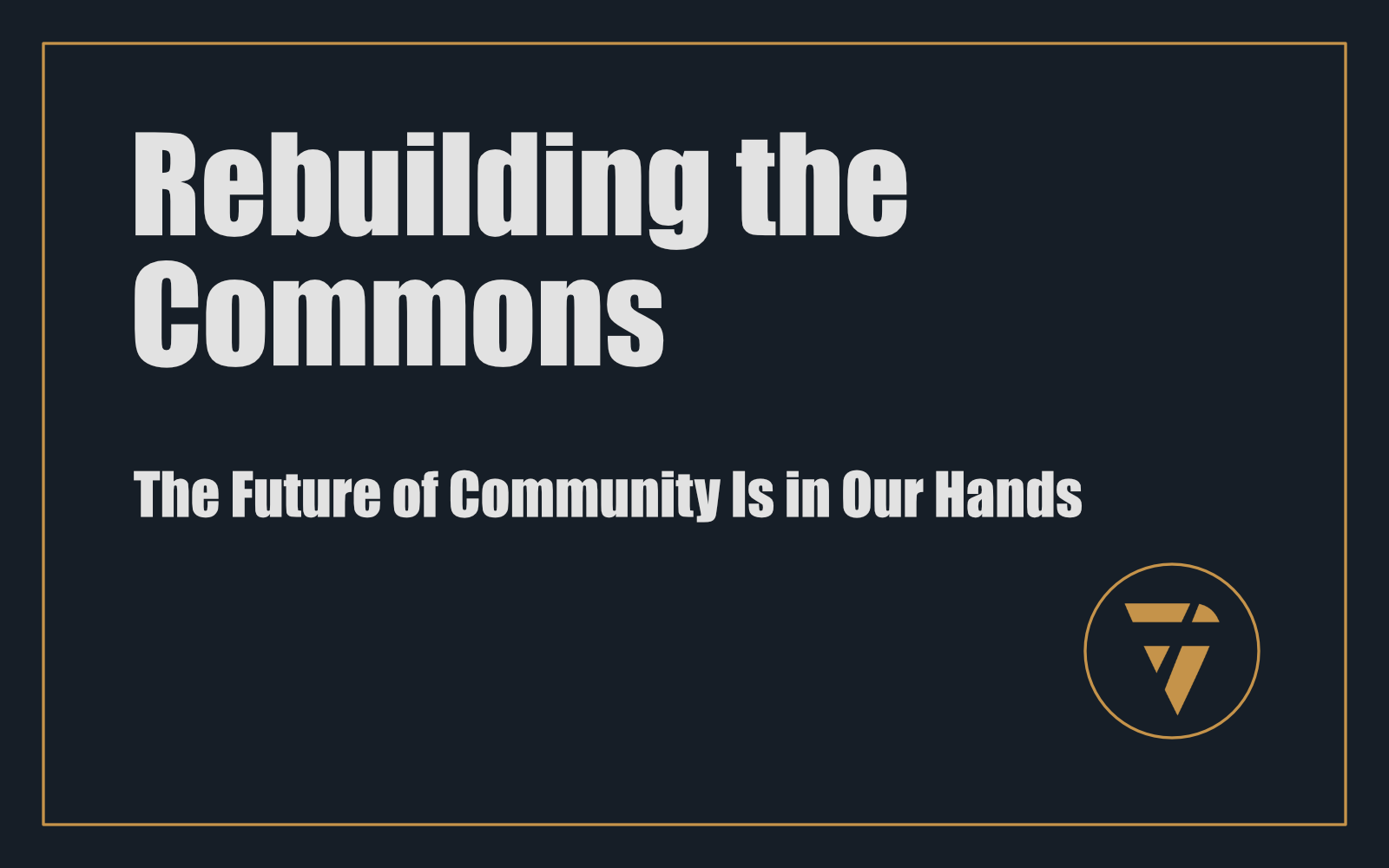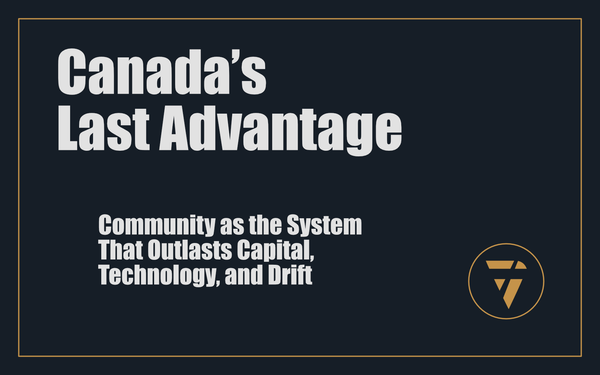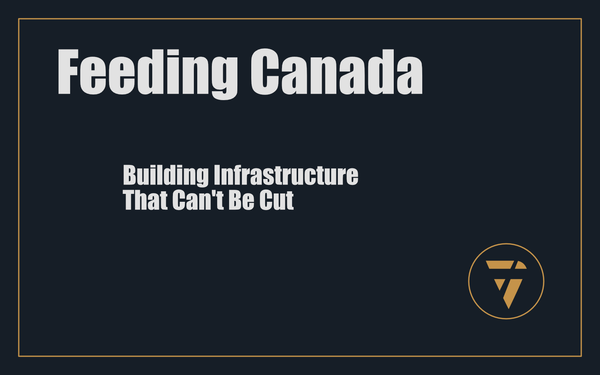Rebuilding the Commons

The Future of Community Is in Our Hands
Once, there were places where we gathered, not just physically, but with purpose. Town halls, community clinics, co-operative meetings, church basements, labour halls. These spaces weren’t just about issues or causes; they were where people saw each other, where they learned to talk, to negotiate, to disagree productively. The architecture of community—both literal and social—gave us the tools to work through problems together.
And yet, in the span of a few generations, that architecture has crumbled.
Today, we live in a paradox: more connected than ever through digital tools, yet more isolated in real terms. The ability to engage meaningfully with those outside our immediate social circles has been eroded. The habit of public discourse has atrophied. The very act of having a conversation—one in which listening is as important as speaking—has become a lost skill.
Harold Chapman, reflecting on the nature of co-operative movements, often reminded people that every few generations, societies must relearn the very things that built them in the first place. Today, we are in such a moment: faced with economic pressures, political divides, and digital disruption, we need to redevelop the architecture of community interaction from the ground up.

The Problem: The Collapse of Civic Infrastructure
The spaces and mechanisms that once facilitated community have either disappeared or become inaccessible:
- Disinvestment in Public Spaces: Libraries, community centres, and local gathering places have seen funding cuts, forcing them to reduce programming or close entirely.
- The Loss of the Middle Institutions: Unions, churches, fraternal organizations, and neighbourhood associations—once the bedrock of social engagement—have declined in membership and influence.
- Digital Displacement of Dialogue: Conversations that once happened face-to-face now occur through fragmented online interactions, often designed to amplify outrage rather than foster understanding.
- A Culture of Transaction Over Relationship: Many modern interactions—whether in commerce, politics, or even community engagement—have become transactional. Without a long-term sense of shared investment, people disengage.
The result? A society where people feel disconnected, unheard, and unable to influence the systems that govern them.
But these systems are not inevitable. They were built. And what was built once can be built again.
Rebuilding the Architecture of Community Interaction: A Proconsul Perspective
Restoring meaningful community engagement isn’t about nostalgia, it’s about adaptation. The conditions have changed, but the need for shared spaces, trust, and civic capacity remains the same. Here’s how we do it:
1. Redesigning the Physical and Digital Commons
Communities need spaces—real and virtual—where people can gather without an agenda other than connection. This means:
- Investing in Civic Spaces: Reclaiming underutilized areas—schools after hours, libraries, empty storefronts—as community hubs.
- Building Digital Commons: Platforms owned and governed locally, not controlled by ad-driven algorithms, where community concerns can be discussed productively.
- Multi-Use Gatherings: Hybrid events that combine social interaction, education, and practical action (e.g., a healthcare town hall held at a community meal).
2. Reviving the Lost Art of Conversation
People no longer know how to talk to each other across divides. This is not just a cultural problem, it's an infrastructure problem. We need to:
- Train Conversational Skills: Schools, workplaces, and community groups must actively teach the skills of deep listening, questioning, and debate.
- Embed Facilitators in Community Meetings: Structured dialogue with trained mediators can help rebuild trust where conflict has fractured communities.
- Normalize ‘Uncomfortable’ Conversations: Encourage spaces where people can work through disagreement without fear of cancellation or escalation.
3. Shifting from Transactional to Relational Models
Modern interaction is dominated by short-term thinking. In contrast, sustainable communities are built on long-term relationships. This requires:
- Returning to Co-Operative Models: Encouraging ownership structures that prioritize collective benefit over individual profit.
- Strategic Partnerships Over Performative Activism: Moving beyond social media advocacy into sustained, collaborative efforts between community groups, businesses, and governments.
- Rethinking Leadership: Instead of top-down decision-making, empower distributed leadership where individuals take responsibility for small but meaningful actions.
4. Institutionalizing Civic Literacy
Most people today feel powerless, not because they're apathetic, but because they don’t know how to engage with civic systems effectively. We must:
- Teach Practical Civic Engagement: Schools should prioritize courses on local governance, negotiation, and problem-solving.
- Make Civic Participation Accessible: Streamline the bureaucracy of community input: simplify meetings, reduce jargon, and ensure meetings aren’t scheduled at exclusionary times.
- Reclaim Accountability Mechanisms: Implement community-driven scorecards that publicly track whether elected officials and institutions follow through on commitments.
5. The ‘No Spectators’ Principle: Restoring Agency
The fastest way to re-engage a disengaged population is to make participation feel meaningful. We do this by ensuring:
- Every Event Has an Actionable Outcome: Whether it’s a town hall or a neighbourhood cleanup, attendees must leave knowing what they can do next.
- Micro-Engagement Options Exist: Not everyone can run for office, but everyone can take a small, repeatable action that contributes to community strength.
- Success is Measured in Relational Growth: Instead of fixating solely on numerical turnout, we should track increases in long-term community involvement.
The Future: Small Wins, Scaled
Rebuilding civic interaction isn't about waiting for governments or institutions to fix things from the top down. It's about proving, through small wins, that people still can come together to solve their own problems.
This will not be a single movement. It will be a thousand local movements, loosely connected, each adapting these principles to their own context.
It starts with one gathering. One conversation. One shift from passive consumption to active participation.
Harold Chapman was right: Every few generations, we have to relearn the why and how of building community.
Now is one of those moments. The question is, will we answer it?
This is what I’m working on. Tell me what you think, I enjoy the conversation! Subscribe and follow the work in real time.
Thanks!
B

Three generations after any pivotal event, the memory of the why fades. We have to learn it all over again.
Community isn’t a given, it’s built. It’s time to rebuild the architecture of conversation, trust, and action. No one is coming to fix it for us.
Start talking.
PS -

Thank you for the conversation Laurie :)
And for introducing me to Harold.







